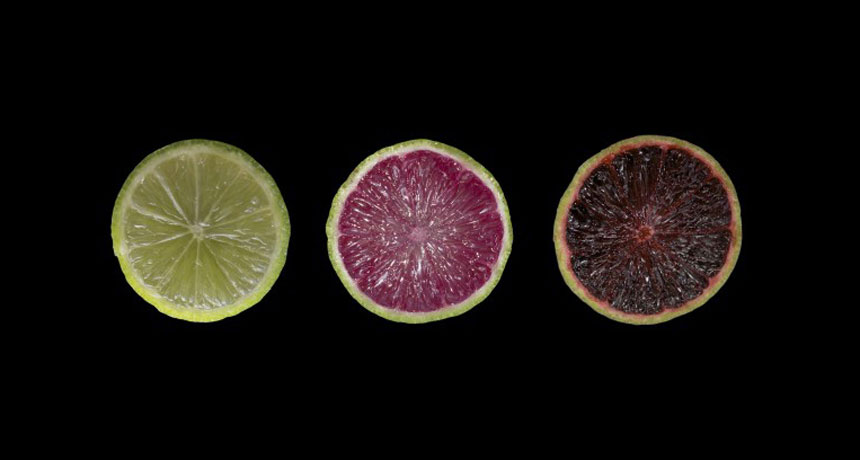From lime green … to lime purple?
Genetic tweaks give citrus a redder color and an added health boost

Normal limes (left) are green. The flesh turns pink with the addition of genes from blood oranges (center). Add genes from red grapes and the lime’s flesh darkens to purple (right).
UF/IFAS
Share this:
- Share via email (Opens in new window) Email
- Click to share on Facebook (Opens in new window) Facebook
- Click to share on X (Opens in new window) X
- Click to share on Pinterest (Opens in new window) Pinterest
- Click to share on Reddit (Opens in new window) Reddit
- Share to Google Classroom (Opens in new window) Google Classroom
- Click to print (Opens in new window) Print
When you think of limes, the color purple doesn’t come to mind. But scientists have tweaked the genes of one kind of lime. Its skin remains the standard green. But cutting the fruit open reveals a surprising lavender- to ruby-colored flesh. The goal was not to make a freaky fruit. Their redder flesh could actually be healthier.
The limes’ new color — and healthier nature — come from anthocyanins (AN-thoh-CY-uh-nins). These are natural red and violet plant pigments. People have been eating anthocyanins in fruits and vegetables since prehistoric times, notes Manjul Dutt, who led the study. That’s the period before humans could write, But, most citrus plants can’t make anthocyanins when grown in subtropical and tropical climates. It takes cooler regions, such as those found in Sicily and southern Italy, he explains, for plants to produce these pigments.
And those pigments are more than eye-appealing. Over time, eating more of them is associated with less weight gain, says Monica Bertoia. She was not involved in the new lime research. She works at Harvard University’s School of Public Health in Boston, Mass. As an epidemiologist (EP-ih-DEE-mee-OL-oh-gizt), she helps investigate factors that may help explain risks of disease.
Other research has also suggested that diets rich in anthocyanins may help prevent obesity and diabetes, notes Dutt. He’s a horticulturist, or expert in growing fruits, vegetables and plants. He works at the University of Florida Citrus Research and Education Center in Lake Alfred.
His team wanted to see if they could get certain fruits to produce anthocyanins even when grown in warm regions, such as Florida. For their new experiments, the scientists took genes for making anthocyanins from red grapes and blood oranges. They inserted these genes into limes and other types of citrus fruits.
Adding genes from one species into another is called genetic engineering. This tweaking of the limes’ genetic code made the new plants’ white flowers take on new hues that ranged from light pink to fuchsia. More importantly, the fruit’s light-green flesh also became a deep maroon or pink.
The new results show that it is possible to grow fruits rich in anthocyanins in warm climates, the researchers conclude. They describe their new findings in the January Journal of the American Society for Horticultural Science.
“Producing fruit with more anthocyanins could help improve the quality of the fruit,” Bertoia says. Still, she adds, “We don’t know what other aspects of the fruit, if any, may change in the process.”
Doing tests to ensure that such tweaked fruits are safe and healthier than their common citrus cousins is the next step, Dutt says. As climates warm, he notes, genetically altered fruits may be the only option for growing tropical citrus rich in the healthy, reddish pigments.
Power Words
(for more about Power Words, click here)
anthocyanins Plant pigments that appear red or purple.
citrus A genus of flowering trees that tend to produce fruits with a juicy edible flesh. There are several main categories: the oranges, mandarins, pummelos, grapefruits, lemons, citrons and limes.
climate The weather conditions prevailing in an area in general or over a long period.
diabetes A disease where the body either makes too little of the hormone insulin (known as type 1 disease) or ignores the presence of too much insulin when it is present (known as type 2 diabetes).
epidemiologist Like health detectives, these researchers figure out what causes a particular illness and how to limit its spread.
expression (in genetics) The process by which a cell uses the information coded in a gene to direct a cell to make a particular protein.
gene (adj. genetic) A segment of DNA that codes, or holds instructions, for producing a protein. Offspring inherit genes from their parents. Genes influence how an organism looks and behaves.
genetic engineering The direct manipulation of an organism’s genome. In this process, genes can be removed, disabled so that they no longer function, or added after being taken from other organisms. Genetic engineering can be used to create organisms that produce medicines, or crops that grow better under challenging conditions such as dry weather, hot temperatures or salty soils.
horticulture The study and growth of cultivated plants in gardens, parks or other non-wildlands. Someone who works in this field is known as a horticulturalist. These people may also focus on pests or diseases that affect cultivated plants, or weeds that may bully them in the environment.
obesity Extreme overweight. Obesity is associated with a wide range of health problems, including type 2 diabetes and high blood pressure.
pigment A material, like the natural colorings in skin, that alter the light reflected off of an object or transmitted through it. The overall color of a pigment typically depends on which wavelengths of visible light it absorbs and which ones it reflects. For example, a red pigment tends to reflect red wavelengths of light very well and typically absorbs other colors. Pigment also is the term for chemicals that manufacturers use to tint paint.
tropics The region near Earth’s equator. Temperatures here are generally warm to hot, year-round.







